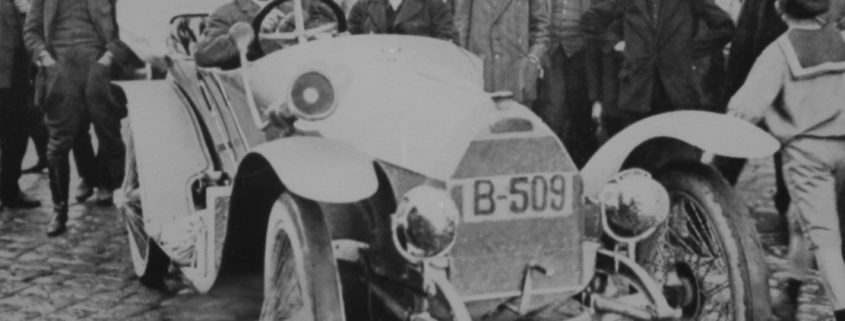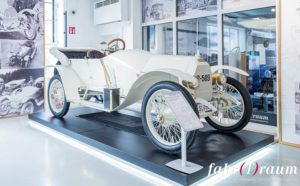Austro Daimler Alpenwagen Year of manufacture 1911 now at fahr(T)raum
The last surviving AD 9/27 Alpenwagen stands in Mattsee
The Ferdinand Porsche Erlebniswelten fahr(T)raum Mattsee/Salzburg is currently displaying an AD 9/27 HP Alpenwagen. This sports car – a successful further development of the AD 20 HP – is the only surviving car of this type; one other was destroyed in a fire.
In the autumn of 1910, Austro Daimler, under the technical direction of Ferdinand Porsche completed the Alpenwagen. Contrary to its predecessor, it featured the following technical details: larger valves, shorter inlet port, lighter connecting rods and pistons, an optimised outlet port and a perfectly balanced fly wheel with balancing machine.
Austro Daimler « Alpenwagen » at fahr(T)raum, Mattsee.
The Alpenwagen was manufactured from 1911 until 1922 and underwent extensive modifications to the AD 25 HP in 1918. There are no records about how many Alpenwagen were built in total; estimations range from 100 to 200 vehicles. The Old-timer Exhibition at fahr(T)raum is now presenting the last existing model. The displayed Alpenwagen was completely rebuilt under the guidance of Ernst Piëch and is now exhibited in an as-new condition.
The success of the Alpenwagen became evident as early as 1911, when it made its debut at the International Non Stop-Alpenfahrt. At that time, it was considered the most difficult, significant and publicity-attracting test drive for touring cars. The Alpenfahrt was an annual event from 1910 until 1914, organised by the K.K. Österreichischen Automobilclub.
During the drive in 1911, there had been four non-stop legs over a total of 1424 km and six alpine passes. The touring cars had to be in operation non-stop for four consecutive days – incredible even at today’s standards.
The first leg went for 315 km from Vienna to Aussee. The second leg went from Aussee to Trieste (404 km). The third leg comprised 303 km from Trieste to Klagenfurt. The fourth and last leg went from Klagenfurt back to Vienna over a distance of 404 km. The motor was not allowed to stop throughout the entire drive; otherwise, penalty points were awarded. The Austro Daimler factory team with the pilots Ferdinand Porsche, Eduard Fischer and Heinrich Graf Schönfeld absolved the entire race without penalty points and won the large gold medal.
Quellen
Bildnachweis
Foto Alpenwagen © Taro Ebihara
Das könnte Sie auch interessieren:








« King of the Mountains » Hans Stuck and his Austro Daimler racing cars
/dans Geschichte, Non classifié(e), Rennautos, Sonstige FahrzeugeA ADM-R racing car and a ADM-R « Torpedo » (1929) now in fahr(T)raum Anyone scrutinising the history of European automobile racing sport in the last century will have encountered his name: Hans Stuck (1900-1978). The Bavarian started his career rather modestly as a milk delivery man where, as legend would have it, his driving style turned […]
Original 1949 Porsche Konstruktionen GesmbH (Gmünd) water turbine now in fahr(T)raum
/dans Geschichte, Lebensstationen, Motoren, Non classifié(e)In the years between 1944 and 1950, the Porsche works in Gmünd/Carinthia, which operated under the name Porsche-Konstruktionen-Ges.m.b.H., produced not only the Porsche 356 No. 1 Roadster but also designs for racing cars, tractors, cable winches, ski lifts and crossflow turbines. The Type 291 crossflow turbine – on loan from the Porsche Automuseum in Gmünd […]
Automobile advertising of the 20s and 30s
/dans Geschichte, Non classifié(e), SonderausstellungHow were cars advertised in the 20s and 30s? How was society made aware of new achievements in the automotive industry and the brands behind them and persuaded to buy motor vehicles? In the Ferdinand Porsche Worlds of Experience, a special exhibition answers these questions and provides insights into the first advertising subjects, their creators […]